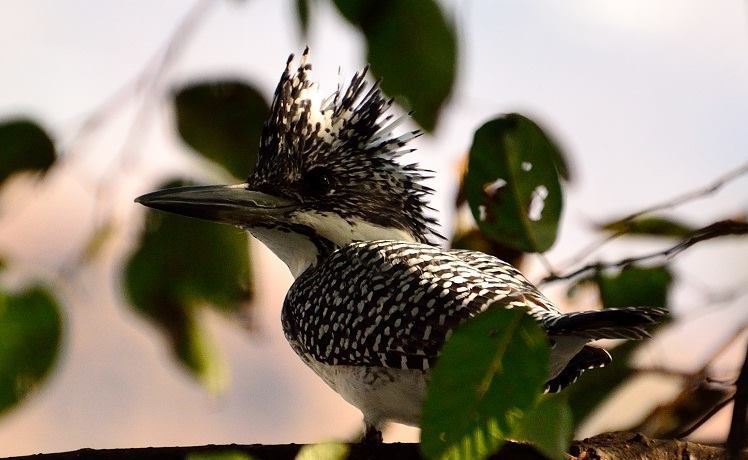
Megaceryle lugubris (Crested kingfisher)
Megaceryle lugubris, also known as the Crested Kingfisher, is one of the most striking bird species found in the Great Himalayan National Park (GHNP). Known for its dramatic black-and-white plumage and distinctive crest on its head, this large kingfisher is a skilled fisher, often seen perched near fast-flowing rivers and streams within the park. The Crested Kingfisher’s robust build and striking appearance make it a favorite among birdwatchers visiting GHNP.
The Crested Kingfisher is primarily found in the Tirthan Valley and Sainj Valley, where its natural habitat includes fast-moving streams, rocky riverbeds, and dense riverside vegetation. It is most active during the early morning and late afternoon, when it hunts for fish and other aquatic prey.
Habitat and Distribution in GHNP
In the Great Himalayan National Park, the Crested Kingfisher is typically found along the Tirthan River and Sainj River, where the swift waters and rocky landscapes provide an ideal environment for hunting. The species thrives at altitudes ranging from 1,200 to 2,500 meters, inhabiting areas where large rivers and streams are surrounded by dense forest and shrubs.
This bird is most commonly seen in areas of dense riparian vegetation, where it can easily find fish and other prey. It may also be spotted on rocky outcrops or tree branches near water, where it waits patiently for its prey to swim into view.
Behaviour and Diet
The Crested Kingfisher is an aquatic hunter, known for diving into rivers to catch fish and small aquatic creatures. Its sharp beak and powerful flight allow it to capture prey with incredible precision. It is also known to hunt insects and crustaceans that live in the river’s shallow waters.
This bird often uses a perch near the water, watching for movement in the stream below. When it spots its prey, it takes off in a quick dive, using its sharp beak to grab fish. After catching its meal, it will return to the same perch to consume its catch.
Conservation Significance
The Crested Kingfisher is not currently listed as endangered, but it is classified as Near Threatened by the International Union for Conservation of Nature (IUCN) due to its reliance on healthy river ecosystems. In the Great Himalayan National Park, the protection of natural habitats, including rivers and forests, plays a crucial role in supporting the populations of this unique bird.
Efforts to preserve the park’s riverine ecosystems are essential for maintaining a stable environment for the Crested Kingfisher and other river-dependent species.
| Common name | Crested Kingfisher |
| Scientific name | Megaceryle lugubris |
| Family | Cerylidae |
| Description | It is a very large (41 cm) black and white kingfisher evenly barred wings and tail. It lacks a supercilium and has a spotted breast, which is sometimes mixed with rufous. This bird is mainly found in mountain rivers and larger rivers in foothills. It is one of the more spectacular birds of the area with its barred black-and- white appearance. It is commonly found in streams between 250-1800m. |



